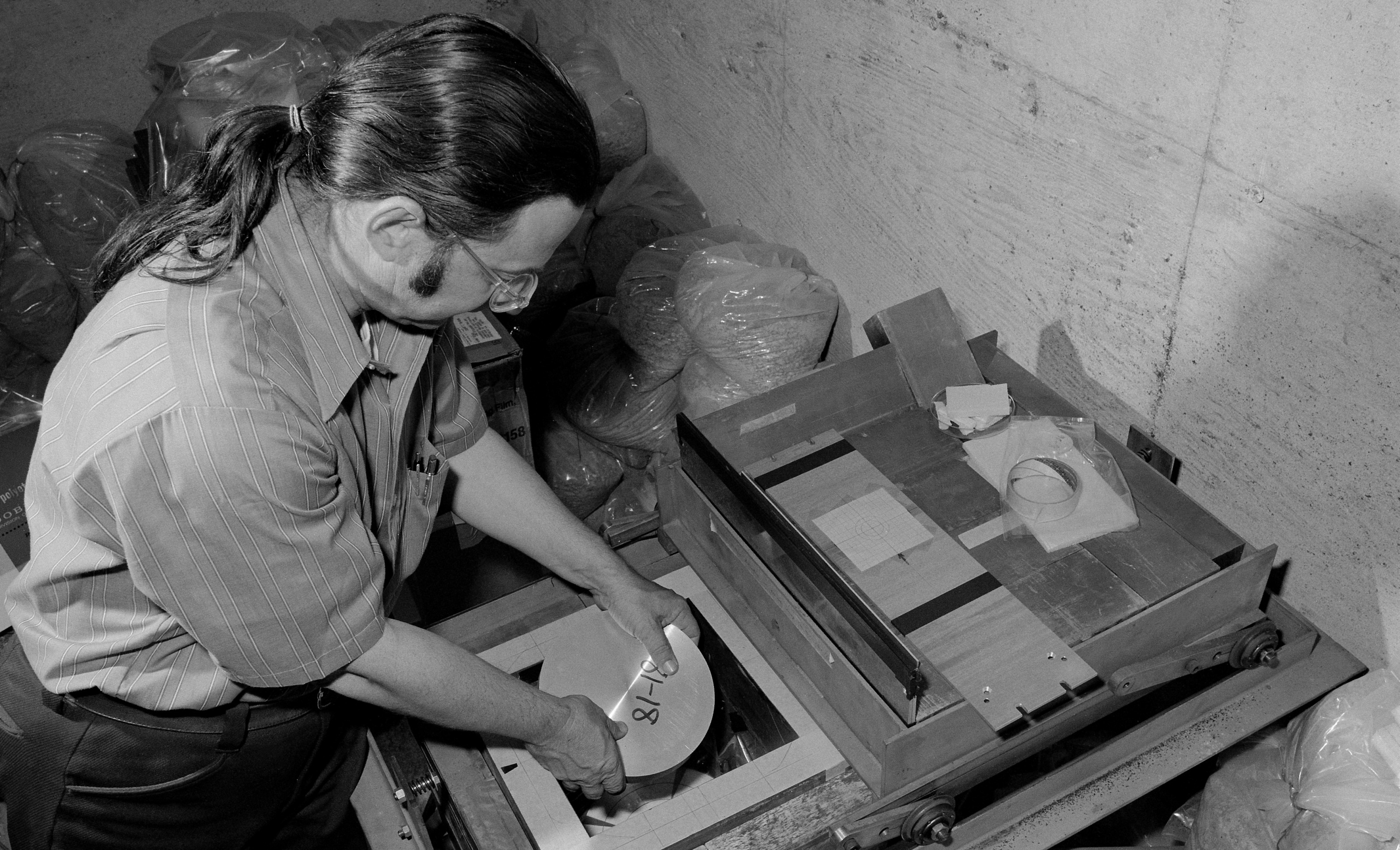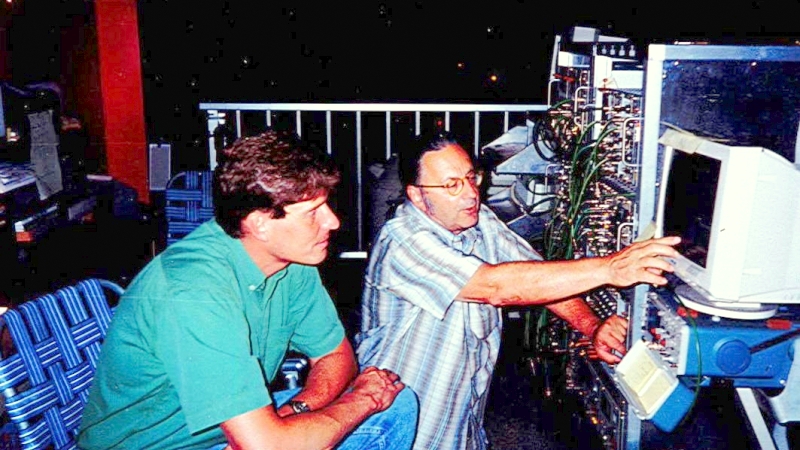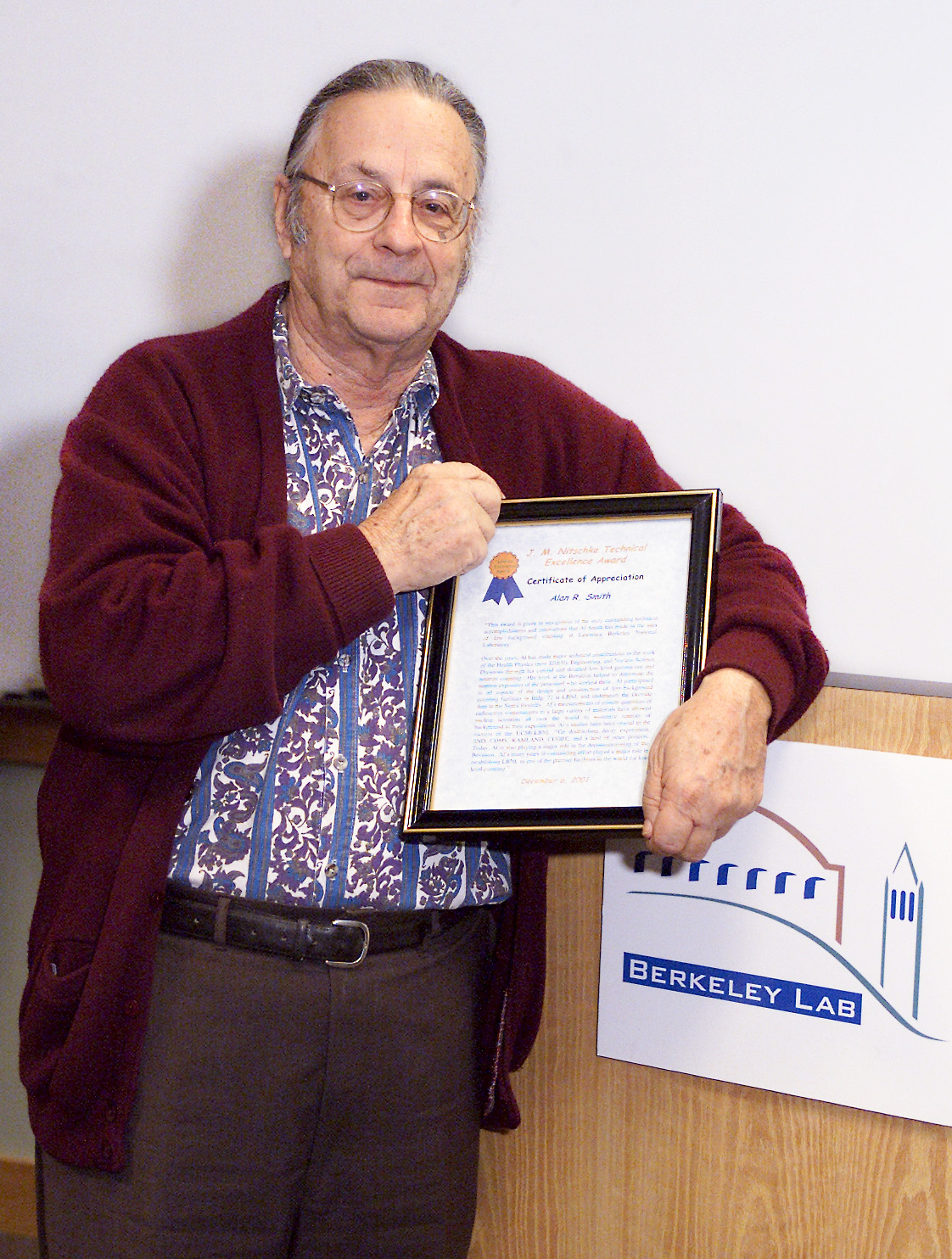
Alan “Al” Smith places an aluminum sample exposed to radiation at Berkeley Lab’s Bevatron accelerator into a lead and concrete box containing a detector at a low-level radiation counting facility in this 1950s photograph. (Credit: Berkeley Lab)
Note: This article was adapted from an article originally published by the Sanford Underground Research Facility. View the original article.
In 1953, Alan “Al” Smith arrived for his first day of work at the U.S. Department of Energy’s Lawrence Berkeley National Laboratory (Berkeley Lab). Over the next seven decades, Smith would greatly advance the science of ultrasensitive particle detectors.
Smith worked to improve the “low-background counting” performance of these detectors – their ability to see ever-fainter signatures of particle interactions.
He officially retired in 1994, but continued to come to the Lab until 2018. By age 92, Smith had created a “gold standard” of gamma-ray assay counting at Berkeley Lab – a measure of a material’s radioactivity – and established a legacy within the particle and nuclear physics research communities.
“Al’s career has always been in the background of nuclear science – literally,” said Keenan Thomas, Nuclear Counting Facility Manager at Lawrence Livermore National Laboratory, who was previously mentored by Smith at Berkeley Lab as part of a Berkeley Low Background Facility (BLBF) team.
Quieting the search
Searches for never-before-seen particle interactions, such as the Majorana Demonstrator’s search for neutrinoless double-beta decay or LUX-ZEPLIN’s (LZ) dark matter hunt, don’t just need to be shielded from cosmic rays – they also require some of the world’s cleanest materials. By “clean,” researchers mean radio-pure; they are looking for materials with the lowest concentrations of radioactivity.
As radioactive elements such as uranium, thorium and potassium decay, they emit signals that quickly light up ultrasensitive detectors and overwhelm rare-event signals. To lessen these misleading signatures, researchers use devices known as low-background counters (LBCs), which can detect and precisely measure even the tiniest amounts of radioactivity in materials and components.
“Low-background counting is a tedious yet critical quality-control step toward the success of rare-event experiments,” said Thomas. “Low-level assays are one of our last lines of defense to ensure that an experiment will be successful in achieving the sensitivity to the very weak signals it was designed for – and not be masked by spurious background signals generated from many different sources, including the materials in the detector itself.”
Going deeper for science
Smith’s career both paralleled and propelled advances in low-background counting. When Smith began his work in the 1950s, nuclear science was a relatively new and booming field. The Bevatron particle accelerator came online at Berkeley Lab in 1954, and Smith was initially tasked with assessing the stray neutrons it produced – neutrons are particles in atomic nuclei that do not carry an electric charge.
To do this, he placed large aluminum discs called “activation foils” around the perimeter of the Bevatron to “capture” neutrons that scattered from the accelerator. By later measuring radioactivity in these foils with sodium iodide detectors, Smith determined the amount of neutrons produced using weak signals from the trace amounts of radioactivity generated in the foils.
Smith realized that the Bevatron itself created a dynamic background that clouded the measurements. To reduce this noise, a low background “cave” was constructed using a single pour of concrete, with walls ranging from 4-6 feet thick. Smith and a graduate student, Harold Wollenberg, carefully counted dozens of samples of concrete source materials to find a supply with the lowest levels of naturally occurring radioactive elements. The dense walls reduced external backgrounds from the Bevatron, cosmic rays, and natural radioactivity in the environment – all with the benefit of not emitting a significant amount of background themselves. This cave became the surface location for the BLBF and is still in use today.

In this 1990s photo, Alan Smith (right) discusses data recorded at the Oroville facility – where a dark matter and neutrinoless double-beta decay experiment was housed – with Dave Martinez, key account manager for AMETEK ORTEC. (Credit: Berkeley Lab)
In the 1980s, Smith became involved with the UC Santa Barbara and Berkeley Lab double-beta decay experiment, which used high-purity germanium detectors. Originally installed in the low-background cave at Berkeley Lab, researchers soon realized the backgrounds from cosmic rays were still too high. Smith turned to his professional connections at the underground Hyatt Power Plant at California’s Oroville Dam to secure a space for the experiment a few hundred feet below ground. The underground space supplied more shielding for the experiment, and housed low-background counters for BLBF for decades.
In 2014, the BLBF at Oroville was relocated to the Black Hills State University Underground Campus (BHUC) in South Dakota, nearly a mile deep at the Sanford Underground Research Facility (Sanford Lab). Before the move, Smith assayed hundreds of samples from this level, including natural rocks, concrete, shotcrete, paint, and other materials to determine the amount of background radiation.
His attention to these samples from the underground construction of the Davis Campus created ample radiopurity data that researchers now use in simulations for Sanford Lab experiments. Once the transition to BHUC was completed in 2015, Smith and his team received and analyzed data online at Berkeley Lab.
Today, the BLBF performs low-background counting in its two unique facilities – the surface site at Berkeley Lab and the underground site at Sanford Lab. Researchers assaying their materials from a distance can monitor results in real time while relying on daily support from Sanford Lab staff and BHSU faculty and students. Support includes changing samples in the detectors, monitoring the liquid-nitrogen systems that purge radon from inside the detectors, and assistance in the installation of detectors underground.
“The campus at Sanford Lab is an ideal location for these counters,” said Kevin Lesko, senior scientist at Berkeley Lab. “Not only does its depth create a shield for the detectors, but it’s in the thick of major physics experiments – it’s where the action is.”
Both locations owe much of their design and creation to Smith’s meticulous measurements.
Creating a “gold standard”
Throughout his career, Smith pushed the capabilities of low-background counting, striving to make more measurements, and more sensitive measurements. As technology advanced, his methods of detection graduated from sodium iodine (NaI) to germanium lithium-drifted (GeLi), and eventually to high-purity germanium detectors (HPGe).
With each advancement, his methods became more sensitive, driving the need for more ultrapure materials. Reducing backgrounds necessitated knowledge of the naturally occurring radioactivity of common materials used in the shielding and detectors themselves.
As he measured countless materials for various projects, Smith developed a deep expertise that became crucial to research into neutrinos, neutrinoless double-beta decay, and dark matter – experiments that required extreme radiopurity in detector materials to detect extremely rare, weakly interacting signals.
His vast knowledge of the backgrounds in common materials, including metals, composites, and ceramics, brought many researchers at Berkeley Lab to him first when conceptualizing experiments. Researchers would ask what they should use to create a component of their experiment, and Smith would quickly point them toward the materials with the lowest levels of natural radioactivity.
“We have immense trust in Al’s judgement,” said Alan Poon, deputy director of the Berkeley Lab Nuclear Science Division, who worked with Smith on multiple projects, including the design and construction of the Majorana Demonstrator detector. “Looking at the counting data from a sample, he could sometimes give us an entire history of the material and the impact it would make on our experiment,” Poon said.
Before Smith left Berkeley Lab in 2018, he had contributed to dozens of high-profile physics experiments, including the Nobel Prize-winning SNO experiment, KATRIN, the Daya Bay Reactor Neutrino Experiment, LUX, LZ, Majorana, CUORE, DM-Ice, LBNE (the precursor to LBNF/DUNE), Double Chooz, KamLAND.
“I don’t think we would have achieved what we did without Al’s work,” said Poon. “He set the gold standard for low-background counting.”
Looking forward
Sanford Lab benefits tremendously from the impacts of Smith and his team. His scrupulous records of underground backgrounds inform researchers’ simulations, and the materials he screened are part of the Majorana Demonstrator and LZ dark matter detectors.
Most notably, his influence is seen at the BLBF on the 4,850-foot level at Sanford Lab, where six low-background counters quietly collect data using high-purity germanium detectors. Here, the same detectors once used for measuring materials for the LUX dark matter experiment and the Majorana Demonstrator will continue counting for next-generation experiments, including LZ, LEGEND and the Deep Underground Neutrino Experiment.
–The original article was written by Erin Broberg of Sanford Lab.
###
Founded in 1931 on the belief that the biggest scientific challenges are best addressed by teams, Lawrence Berkeley National Laboratory and its scientists have been recognized with 13 Nobel Prizes. Today, Berkeley Lab researchers develop sustainable energy and environmental solutions, create useful new materials, advance the frontiers of computing, and probe the mysteries of life, matter, and the universe. Scientists from around the world rely on the Lab’s facilities for their own discovery science. Berkeley Lab is a multiprogram national laboratory, managed by the University of California for the U.S. Department of Energy’s Office of Science.
DOE’s Office of Science is the single largest supporter of basic research in the physical sciences in the United States, and is working to address some of the most pressing challenges of our time. For more information, please visit the Office of Science website at science.energy.gov.
The Sanford Underground Research Facility’s mission is to enable compelling underground, interdisciplinary research in a safe work environment and to inspire our next generation through science, technology, engineering, and math education. For more information, please visit the Sanford Lab website at http://www.sanfordlab.org.
